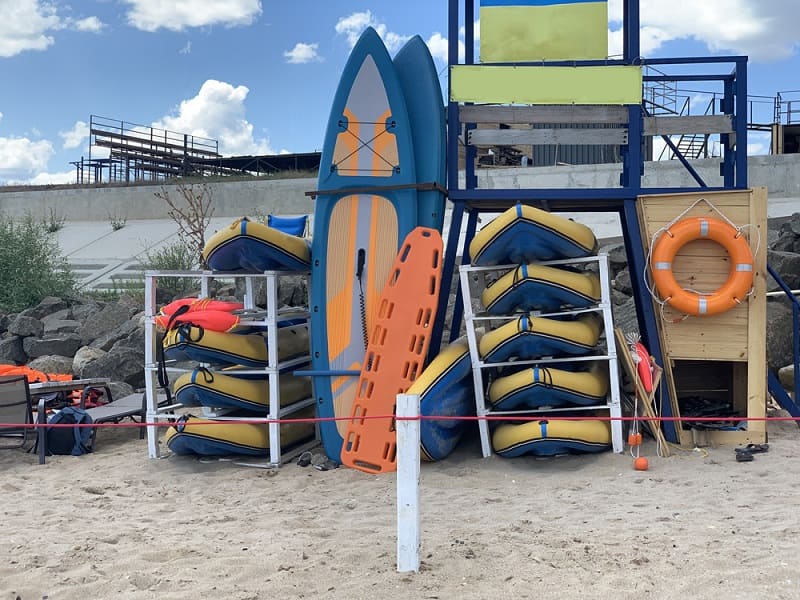You just invested in a brand new inflatable kayak. You’re ready to hit the water and enjoy riding the rapids.
But before you head out there, you need to know just how long you can leave your boat inflated. Is it okay to keep a kayak inflated while you’re not using it?
Can you store or transport your boat while it’s inflated?
And if you were to leave your boat permanently inflated, how long would it last before starting to lose air on its own?
Great questions! Let’s dive in and explore the answers.
Table of Contents
Can You Leave an Inflatable Boat Inflated?

Inflatable boats are made to hold air, but just how long are they supposed to do it? Is it okay to leave inflatable boats inflated when you’re not using them?
Technically speaking, you can leave these boats inflated, but in most cases, you really shouldn’t–at least not for long periods.
Leaving any inflatable boat inflated can cause the seams to weaken over time. This will quite possibly lead to air leaks around the seams and valves. Leaving the boat inflated may also cause the air chamber material to break down over time.
It is okay to keep your kayak or other boats inflated for short periods when you’re not using it–for example, when you take it out of the water to move it from one part of the lake to the other.
Use your best judgment when deciding whether to inflate or deflate your boat–it isn’t practical to do this every time you move from one place to another, especially if you’re walking past a shallow area or lifting it over a land bridge.
Be careful, though–inflatable kayaks are much easier to damage when they’re inflated. It is safer to move your boat while it’s deflated, in many cases.
If you leave your inflatable boat moored at a dock, you will, of course, have to keep it inflated. If you do this, keep the boat covered and only leave it at the dock for short periods. The longer you leave it inflated and unattended, the higher your chances of sustaining damage.
Can You Store and Transport an Inflatable Boat Inflated?

Some types of inflatable boats are easiest to transport inflated. Large inflatable boats are most easily transported on trailers either partially or fully inflated. Keep these boats covered and protected during the transport.
With kayaks, it isn’t necessary to transport them inflated. They are too small for trailers but too large to fit comfortably inside a vehicle. They don’t take very long to inflate once you reach the water, and they are much easier to transport while deflated and folded up.
You can keep your kayak folded up inside a larger boat or vehicle until you need it, inflate it right before using it, then deflate it again before heading home. The process is easy and doesn’t take a lot of extra time.
If you store your kayak inflated, you should only do so for short periods while leaving it in the water moored to the shore. Doing this is not recommended, as the kayak will be more prone to damage and theft.
Still, if you store your kayak this way, keep it well secured and covered, and again, only leave it at the dock for short periods.
For more long-term storage, it’s best to bring the kayak back to your garage or house. Make sure it is completely clean and dry, then deflate it and fold it up. Keep it out of direct sunlight and away from pets and sharp objects that could damage the air chamber.
How Long Do Inflatable Kayaks Stay Inflated?

The answer to this question largely depends on the kayak–its quality, how old it is, and whether it has been previously damaged.
Some kayaks are better-made than others, with higher-quality materials and stronger welds along the seams. These well-built boats will hold air for longer periods than the average inflatable kayak.
On the other hand, many inflatable kayaks are cheap and poorly made. These boats may only hold air for relatively short periods, and they may develop severe air leaks even while they are still new.
Older inflatable kayaks that have been used repeatedly may not hold air as effectively as newer ones that are fresh out of the box. The exception, of course, would be a high-quality older kayak that has been taken care of–it may hold air better than a new but lower-quality kayak.
Regardless of quality, kayaks that have been overinflated repeatedly or poorly cared for may not hold air as well as those that have been properly inflated and taken care of. If an inflatable kayak has gone over rocks too many times, it may gradually lose its ability to hold air.
Conclusion
With most inflatable boats, it’s best to deflate them when you’re not using them. This is especially true of kayaks, which are easier to transport and store when deflated.
If you leave your inflatable boat inflated, it’s best to do so only for short periods. Make sure the boat is covered and protected from sharp objects.

Sarah Hood has been writing for Anchor Travel since 2021. When she’s not writing, she enjoys cooking, singing, and spending time in the great outdoors.

